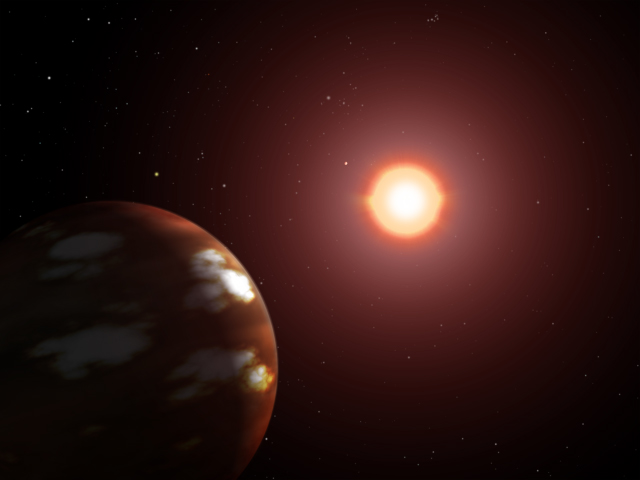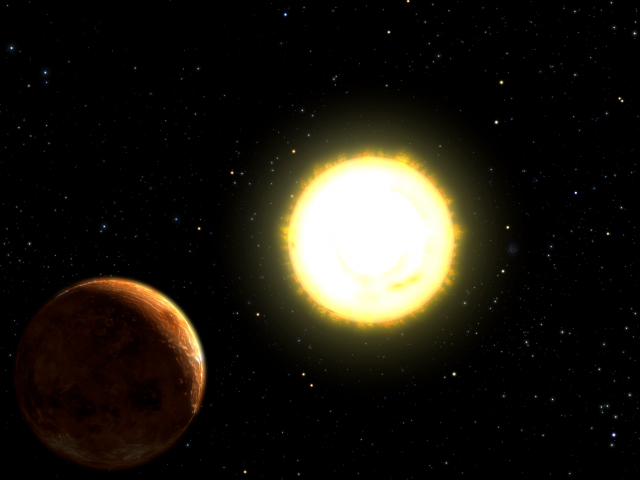| |

In this artist's conception, a newly discovered planet the size of Neptune orbits the cool, reddish M-dwarf star Gliese 436
Credit: NASA/G. Bacon
Select image for larger version
(Size: 247KB) |
| |
| |

In this artist's conception, another Neptune-sized planet orbits the yellow, Sun-like star 55 Cancri. Astronomers have already discovered three other planets around this star, all lying further out.
Credit: NASA/G. Bacon
Select image for larger version
(Size: 355KB) |
| |
| |
Larger versions of all images from this document |
| |
 Note About Images Note About Images |
Arlington, Va.--A team of astronomers has announced the discovery of some of the smallest planets yet detected beyond our solar system: two worlds that represent a new category of extra-solar planets, as well as significant and much-anticipated advance in the hunt for such objects.
Each of newly discovered planets is roughly comparable to the planet Neptune in our own solar system, says Geoffrey Marcy of the University of California, Berkeley, a veteran planet-hunter and a co-discoverer of this pair.
That’s still pretty big on a terrestrial scale, he says: Neptune has 17 times the mass of the Earth. But it’s tiny compared to the 120-plus extra-solar planets that have been discovered to date. Virtually all of those objects are considerably heftier than our own solar system’s heavyweights, Jupiter and Saturn, which have 318 times and 95 times the mass of the Earth, respectively.
In addition, says Marcy, these newly discovered Neptunes may well be the harbingers of many more (and smaller) things to come. Although lower-mass planets like these tend to be harder to detect than their higher-mass cousins, the statistics to date suggest they occur more frequently. And if that’s the case, he says, then an obvious extrapolation suggests that we may soon be seeing many more Neptunes—and that Earth-sized planets, if we can ever detect them, may be downright abundant.
The discovery team was supported jointly by the National Science Foundation (NSF) and the National Aeronautics and Space Administration (NASA). They publicly announced their findings at a NASA Science Update on August 31, 2004, and will publish their results this December as two separate, peer-reviewed papers in the Astrophysical Journal.
On August 25, European astronomers announced preliminary evidence for a third Neptune-sized extra-solar planet.
The first of the two new Neptunes was discovered by a team led by Paul Butler from the Carnegie Institution of Washington, Steven Vogt from the University of California’s Lick Observatory, Marcy, and Debra Fischer from Berkeley and San Francisco State University. The group was following a detection strategy that Marcy and Butler helped pioneer more than a decade ago, and that has accounted for the majority of exoplanet detections so far. Instead of trying for an actual image—even the biggest exoplanet is much too faint and far away for that—they monitored a long list of candidate stars, looking for wobbles that might be caused by the gravitational tug of an orbiting planet. The wobbles would show up as subtle “Doppler shifts” in the starlight; by observing those shifts over a period of years, the astronomers could then infer the planet's approximate mass, orbital size and period.
In this case, the astronomers used one of the twin Keck telescopes on Mauna Kea, Hawaii, to monitor 950 nearby stars, 150 of which were a type of cool, reddish, very low-mass star known as an "M dwarf." Now, M dwarf stars are tough targets for planet hunters, says Marcy. The galaxy is filled with them; indeed, they’re the most abundant type of star in the universe, and presumably have lots of planets. “But they’re hard because they’re so dim,” he says. “Only with the largest telescopes in the world”—for example, the Keck—“can you do the Doppler technique on them, and then only with the very nearest.”
The effort paid off in July 2003, when the astronomers noticed a periodic wobble in Gliese 436, an M dwarf star that lies about 33 light-years from Earth in the direction of the constellation of Leo. Another 12 months of data-taking confirmed the result: Gliese 436 has a Neptune-sized planet of at least 21 Earth masses that goes whipping around in its circular orbit once every 2.64 days. That corresponds to an orbital radius of roughly 4.5 million kilometers, or about 3 percent of Earth’s distance from the sun.
From our terrestrial perspective, this does make for a rather bizarre kind of solar system. Even Mercury, the closest planet to our sun, has an orbital period of 88 days and an orbital radius of 58 million kilometers—more than 12 times further out. And our own Neptune has an orbital period of 165 years and an orbital radius of 4.5 billion kilometers: a thousand times further out. Still, for reasons that no one really understands, such close-in giant planets seem to be the rule among the exo-solar systems discovered so far.
As for what this new planet is like, says Marcy, that is anybody’s guess. It could be a gas giant: a sphere of hydrogen and helium gas similar to Jupiter and Saturn. Or, with a mass near that of Neptune, it could be very much like Neptune: a thick envelope of hydrogen and helium gas surrounding a core of rock and ice. Or, being so close to its sun, it could be just like Mercury: a barren ball of rock and iron.
The other authors on the this first discovery paper are Gregory Henry, Tennessee State University; Greg Laughlin, Lick Observatory and University of California, Santa Cruz; Jason Wright, Berkeley; Jack Lissauer, NASA Ames Research Center.
The second of the new Neptunes was found in orbit around 55 Cancri: a yellow, sun-like star that lies about 41 light-years from Earth in the direction of the constellation Cancer.
In 2002, the same team had already announced their discovery of three planets around 55 Cancri, based largely on observations made by Debra Fischer at Lick Observatory. But over time they found that their subsequent Doppler measurements were beginning to vary from the predicted values in a way that suggested a fourth planet. They accordingly sent all their accumulated observations to University of Texas astronomer Barbara McArthur, who has been organizing a major campaign to study the 55 Cancri system. Combining that dataset with another 100 Doppler measurements taken with the Hobby-Eberly Telescope in Texas, McArthur and her colleagues then confirmed the star does indeed have a fourth planet. It has 18 Earth masses, an orbital period of 2.81 days, and an orbital radius of just 3.8 percent that of Earth.
The composition of this Neptune is as mysterious as the first, says Marcy: it too could be gaseous, rock-ice, or rock and iron.
On the other hand, he says, astronomers will soon have many more examples to study: he and his colleagues alone are already preparing publications on another 20 exoplanets.
In addition to McArthur, the other authors on the second paper are Michael Endl, Fritz Benedict and William Cochran, University of Texas, Austin; Fischer, Marcy, and Butler; Dominique Naef, Michel Mayor, Didier Queloz, and Stephane Udry, Observatoire de Geneve, Switzerland; Thomas Harrison, New Mexico State University.
|

